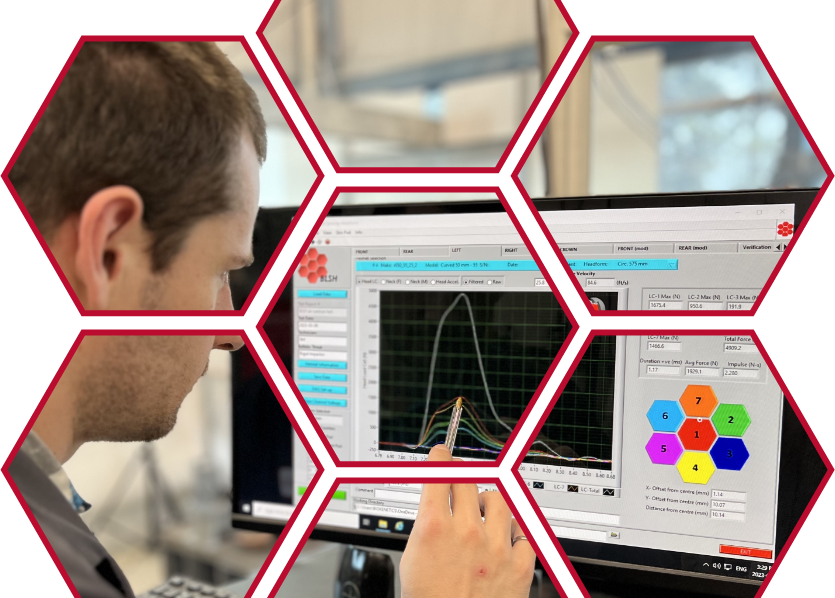Blunt force trauma remains one of the most dangerous and life-threatening forms of injury that can be sustained during various physical activities. Though certain effects of blunt force trauma (BFT) may become externally visible (bruises, breaks, contusions, etc), the risk of internal injuries drastically increases the chance of lethality if left undetected. Blunt force trauma testing plays an integral role in increasing our understanding of how an impact affects the body, what injuries may result, and most importantly, what kind of preventative measures may be implemented to circumvent or lessen the opportunity for such injuries to occur.
With over 45 years of innovative, industry-leading experience, Biokinetics understands how powerful knowledge is when it comes to preventing serious bodily harm. We are proud to partner with regulators, governing bodies and industry suppliers across North America to provide you with information you can trust when it matters most. Below, we’ll discuss the importance of blunt force trauma testing, as well as the benefits of partnering with Biokinetics when it comes to your evaluation needs. Read on to learn more.
What is Blunt Force Trauma?
Blunt force trauma refers to physical injuries caused by non-penetrative impact or forces striking the body. BFT commonly occurs when a solid object strikes or collides with the body, and is frequently associated with falls, motor vehicle accidents, sports, and any other activity that involves the risk of significant concussive force. There are a wide variety of factors that influence the severity of a blunt force injury, including the force of the impact, the area of the body affected, the pre-existing physical condition of the victim, and the type of object involved.
Blunt force trauma testing seeks to evaluate each of the above components and to create a normative baseline that allows for diagnosis, treatment, investigation, prevention, and creation of safety materials and environments that help to mitigate the risk of such injuries occurring. Testing focuses heavily on the following:
Understanding Injury Patterns
While every incident is unique and each injury will have aspects that differ from other occurrences, being able to understand how and why specific injuries occur is essential to reducing risk. By subjecting materials, animal models, or simulated human tissues to controlled impacts, scientists and biomechanical engineers can observe and analyze the physical effects, such as fractures, contusions, and internal injuries. The results of such testing not only provide valuable insight as to how certain impacts cause trauma, how to refine existing injury models and develop better diagnostic tools, as well as improve treatment strategies.
Further Safety Protocols
When it comes to lessening the risk of bodily harm, finding trusted methods of prevention and mitigation is key. BFT plays an integral role in enhancing safety measures across multiple applications by simulating real-world impact scenarios and enabling researchers to evaluate the effectiveness of safety equipment, such as helmets, body armour, and vehicle restraints. The data from such tests can then be used to design superior safety practices and materials that disperse kinetic energy in a less detrimental manner, reducing the negative outcomes of impacts and keeping end-users safe in real-world practices. The information gathered from blunt force trauma is also routinely used to inform manufacturers and policymakers when setting the bar for new safety standards and day-to-day best practices.
Forensic Investigations
While the preferred goal of blunt force testing is to mitigate risk in such a manner that fatalities are circumvented entirely, the unfortunate reality is that, they are an eventuality, even with our best (current) safeguards in place. BFT helps to prevent fatalities and allows for preventative education through the exploration of causes of death following an accident, distinguishing between accidental and intentional injuries, and discerning how repeat occurrences can be avoided.
Improving Product Development
Blunt force trauma testing is also essential when it comes to informing the development, and refinement of consumer products for both the private and public sphere. By subjecting materials, structures, or prototypes to controlled impact tests, manufacturers can evaluate the durability, resilience, and safety features of their designs. BFT helps to identify weaknesses and failure points and allows manufacturers to make key modifications prior to going to market to serve their customer base best and remain compliant with all relevant industry standards.
Building a Safer Path Forward
At Biokinetics, we believe that knowledge is power when it comes to preventing fatalities and dangerous injuries caused by blunt force trauma. For nearly 50 years, we’ve proudly partnered with clients across Canada and North America to offer extensive testing and assessment services for blunt force applications as well as ballistics testing, sports research, and more.
Contact Biokinetics today to learn more!

